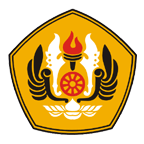Antimalarial Activity of Ethanol Extract of Sampare Leaves (Glochidion sp var. Biak) Against Plasmodium falciparum In Vitro
Abstrak
Malaria is one of the health problems in the world and in Indonesia. This disease is caused by the
protozoan parasite, the genus Plasmodium. Plasmodium falciparum is the most important parasitic
disease with high morbidity and mortality in the world and tropical countries such as Indonesia in
particular. This study aims to determine the activity of sampare leaf extract in inhibiting the growth of
the FCR-3 strain of the P. falciparum parasite which causes malaria. Sampare leaves were extracted by
maceration method using 70% ethanol. Extract the results extraction were tested against P. falciparum
by in vitro method. 32,67% Yield extract resulted from the extraction process. Phytochemical screening
shows the presence of alkaloid compounds, flavonoids, quinones, saponins, and tannins. The ethanol
extract of sampare leaves had IC50 antimalarial activity of 0,125 μg/mL and was categorized very well.
Keywords: Antimalarial, Glochidion sp var. Biak, IC50, Plasmodium falciparum.
Kata Kunci
Teks Lengkap:
PDFReferensi
WHO. World Malaria Report 2020. 2020;1-250. Available from: https://www.who.int/teams/global-malaria- programme/reports/world-malaria- report-2020
Kementrian Kesehatan RI. Buku Saku Tatalaksanan Malaria 2019. 2019;1–44.
Kementerian Kesehatan Republik Indonesia. Vol. 1, Kementerian Kesehatan RI. 2019. Available from: https://www. kemkes.go.id/article/view/19093000001/ penyakit-jantung-penyebab-kematian- terbanyak-ke-2-di-indonesia.html
Moxon CA, Gibbins MP, McGuinness D, Milner DA, Marti M. New Insights into Malaria Pathogenesis. Annu Rev Pathol Mech Dis. 2020;15:315–343.
Milner DA. Malaria pathogenesis. Cold Spring Harb Perspect Med. 2018;8(1):1– 11.
del Prado GRL, García CH, Cea LM, Espinilla VF, Moreno MFM, Márquez AD, et al. Malaria in developing countries. J Infect Dev Ctries. 2014;8(1):1–4.
Dinas Kesehatan Papua. Tumbuhan Obat Tradisional Papua Berdasarkan Kearifan Lokal Masyarakat. Nulisbuku Jendela Dunia; 2016. p. 58–59
Oktalia G, Chrystomo LY, Karim AK. Uji Aktivitas Sitotoksik dan Analisis Fitokimia Ekstrak Etanol Daun Sampare (Glochidion sp.). J Biol Papua. 2018;9(2):49–54.
Budiarti M, Maruzy A, Mujahid R, Sari AN, Jokopriyambodo W, Widayat T, et al. The use of antimalarial plants as traditional treatment in Papua Island, Indonesia. Heliyon. 2020;6(12):e05562.
Moyo P, Kunyane P, Selepe MA, Eloff JN, Niemand J, Louw AI, et al. Bioassay- guided isolation and identification of gametocytocidal compounds from Artemisia afra (Asteraceae). Malar J. 2019;18(1):1–11.
Pandey A, Tripathi S, Pandey CA. Concept of standardization, extraction and pre phytochemical screening strategies for herbal drug. J Pharmacogn Phytochem JPP. 2014;115(25):115–9.
Portet B, Fabre N, Roumy V, Gornitzka H, Bourdy G, Chevalley S, et al. Activity- guided isolation of antiplasmodial dihydrochalcones and flavanones from Piper hostmannianum var. berbicense. Phytochemistry. 2007;68(9):1312–20.
Fenta M, Kahaliw W. Evaluation of antimalarial activity of hydromethanolic crude extract and solvent fractions of the leaves of Nuxia congesta R. Br. Ex fresen (Buddlejaceae) inplasmodium berghei infected mice. J Exp Pharmacol. 2019;11:121–34.
Budiarti M, Jokopriyambodo W. Potensi Ekstrak Daun Paliasa (Kleinhovia hospita) Sebagai Anti Plasmodium falciparum. Bul Penelit Tanam Rempah dan Obat. 2020;31(2):85.
Tiko GH, Medjigbodo A, Adamou R,
Amoussa Amo, Djogbenou LS, Lagnika
L. Scientific Baseline Information for the Potential Use of Hibiscus surattensis L against Malaria: Phytochemistry and Biological Studies. J Drug Deliv Ther. 2020;10(5):127–35.
Sahoo RK, Tamuli KJ, Lhouvum N, Dutta D, Bordoloi M, Sharma HK, et al. Phytochemical constituents from Xanthium strumarium L. and evaluation of their in vitro antimalarial activities. South African J Bot. 2020;135:35–40.
Ezenyi IC, Salawu OA, Kulkarni R, Emeje M. Antiplasmodial activity-aided isolation and identification of quercetin- 4’-methyl ether in Chromolaena odorata leaf fraction with high activity against chloroquine-resistant Plasmodium falciparum. Parasitol Res. 2014;113(12):4415–22.
Parbuntari H, Prestica Y, Gunawan R, Nurman MN, Adella F. Preliminary Phytochemical Screening (Qualitative Analysis) of Cacao Leaves (Theobroma cacao L.). Eksakta Berk Ilm Bid MIPA. 2018;19(2):40–5.
Patel OPS, Beteck RM, Legoabe LJ. Antimalarial application of quinones: A recent update. Eur J Med Chem. 2021;210:113084.
Kumar, D., Kumar, M., Kumar, A., & Kumar Singh, S. Chalcone and curcumin derivatives: a way ahead for malarial treatment. Mini reviews in medicinal chemistry, 2013;13(14):2116-2133.
DOI: https://doi.org/10.24198/ijpst.v10i1.29477
Refbacks
- Saat ini tidak ada refbacks.
| Switch to English Back to Top |
| View My Stats Penerbit Universitas Padjadjaran
Jurnal ini terindeks di :Creative Commons Attribution :
Based on a work at http://jurnal.unpad.ac.id/ijpst/ |
 Indonesian Journal of Pharmaceutical Science and Technology
Indonesian Journal of Pharmaceutical Science and Technology




